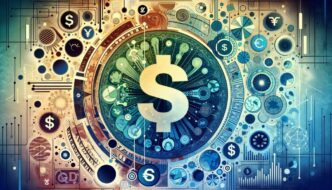The U.S. dollar has recently climbed to a new 52-week high, making waves in the financial markets. This surge can be attributed to the latest set of economic data that has dampened the prospects of aggressive rate cuts by the Federal Reserve (Fed). Additionally, hawkish remarks from Fed Chair Jerome Powell have further fueled the dollar’s ascent. In this article, we’ll explore the factors behind the dollar’s strength, its implications, and what investors should consider moving forward.
Understanding the Current Landscape
The currency market is notoriously volatile, affected by numerous global factors including economic indicators, monetary policy, and geopolitical tensions. The rise of the U.S. dollar against major counterparts like the euro, yen, and pound sterling provides insight into the shifting dynamics of the economy. Recent economic data suggests that the U.S. economy is steadier than many had anticipated, which is a critical factor in investor sentiment.
The Economic Data Driving the Dollar
Several key indicators have recently painted a positive picture of the U.S. economy:
- Steady Job Growth: Payroll data indicated sustained employment growth, which can bolster consumer confidence.
- Inflation Trends: Current inflation rates remain elevated, leading to expectations of persistent interest rates.
- Consumer Spending: Increased consumer spending has provided a boost to GDP forecasts.
Impact of the Federal Reserve’s Stance
One of the main drivers behind the dollar’s rise is the Fed’s stance on interest rates. The possibility of aggressive rate cuts has become increasingly unlikely after Fed Chair Jerome Powell’s recent comments. In a speech that echoed a hawkish tone, Powell emphasized the need to remain vigilant against inflation, signaling to investors that rates may stay higher for a longer period than previously anticipated.
The Strength of the Dollar: A Table Overview
| Currency Pair | Current Exchange Rate | % Change (Last 7 Days) |
|---|---|---|
| USD/EUR | 1.12 | 3.5% |
| USD/JPY | 145.00 | 2.1% |
| USD/GBP | 1.30 | 2.8% |
What This Means for Investors
The implications of the dollar’s strength are multifaceted. Here are several key takeaways for investors:
- Impacts on Import/Export: A stronger dollar makes imports cheaper while exports can become less competitive. Businesses heavily reliant on international trade may need to adjust their pricing strategies.
- Foreign Investment: A robust dollar can attract foreign investment, especially in U.S. assets, as investors seek stability.
- Inflation and Prices: Potentially lowered import costs could lead to moderated inflation, impacting consumer purchasing power positively.
Strategic Investment Opportunities
With the dollar strengthening, investors may consider diversifying their portfolios. Here are practical tips:
- Invest in U.S. Equities: Companies that operate globally may benefit from cheaper imports.
- Consider Currency ETFs: Currency exchange-traded funds can provide exposure to fluctuations in currency value.
- Monitor Commodities: Commodities priced in dollars, like oil, may experience pricing shifts based on dollar strength.
Case Studies: Dollar Performance and Global Events
Historically, several case studies illustrate how the dollar’s strength correlates to global events:
- Global Financial Crises: The dollar typically strengthens during periods of financial instability, as it is viewed as a safe haven.
- Geopolitical Tensions: The dollar tends to appreciate when geopolitical tensions escalate, resulting in increased demand for dollars.
Conclusion: What to Watch For
As the U.S. dollar continues to soar, investors should stay vigilant. Keeping an eye on upcoming Federal Reserve meetings, economic data releases, and global events will provide crucial insights into potential shifts in currency dynamics. It’s vital to integrate this understanding into investment strategies—whether you’re focused on commodities, stocks, or foreign exchange.
the rise of the U.S. dollar amid recent economic data and leaning Fed policy presents both challenges and opportunities. Investors who adapt to these changes will be better positioned to navigate the evolving financial landscape.







